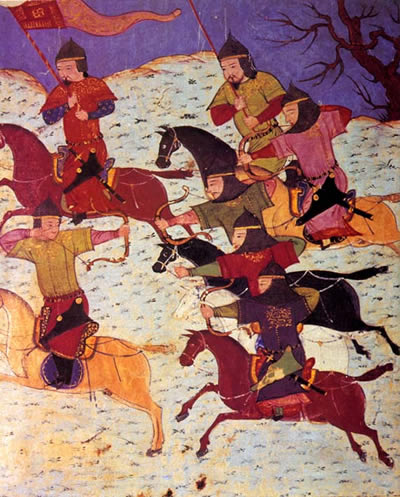In the
Mountains Where The Wild Pheasants Roost
After the yellow dust blows
by June he comes with his tools
dusts out the coffee shop, readies scuba gear
fires up the power boat, tests the jet skis
paints the goose-looking paddle boats
for he knows the families always come
like the summer rain to rice fields
the fall leaves float from chestnut trees.
The mounds of their ancestors rise from hillsides
where thirty-thousand Mongols rode on horseback
their flags flying with thunder over these hills
and the farmers’ daughters hid for safety.
Now the rice-planter skids four rows at a time
and the trumpets sound like a thousand car horns
finely tuned like the archer’s arrow
flies fast over forty kings' graves
and old footpaths criss-cross the hills
where the Mongols slept
their fire lights in the night
as the cuckoos sing
trumpets cry out
to the sky
bring blue

After the yellow dust blows
by June he comes with his tools
dusts out the coffee shop, readies scuba gear
fires up the power boat, tests the jet skis
paints the goose-looking paddle boats
for he knows the families always come
like the summer rain to rice fields
the fall leaves float from chestnut trees.
The mounds of their ancestors rise from hillsides
where thirty-thousand Mongols rode on horseback
their flags flying with thunder over these hills
and the farmers’ daughters hid for safety.
Now the rice-planter skids four rows at a time
and the trumpets sound like a thousand car horns
finely tuned like the archer’s arrow
flies fast over forty kings' graves
and old footpaths criss-cross the hills
where the Mongols slept
their fire lights in the night
as the cuckoos sing
trumpets cry out
to the sky
bring blue

Over 3 decades the Mongols invaded Goryo (modern Korea) 6 times. In 1231 Genghis Khan's 3rd son Ögedei Khan sent Sartaq against the kindgom and forced it to surrender and pay an indemnity of 10,000 otter skins, 20,000 horses, 10,000 bolts of silk, clothing for 1,000,000 soldiers, and a large number of children and craftsmen. In response, the following year the military dictator Choe U transferred the capital from Songdo (modern Kaesong, in North Korea) to the nearby Gangwha island as a protective measure. Unable to take the new capital directly, the Mongols waged war against the peasantry. The Mongo; after Saritai was killed by the Buddhist monk Kim Yunhu in 1232, the Mongols withdrew again. A new assault was launched in 1235, forcing another surrender. The Mongols demanded the royal family as hostages, but king Gojong swnr unrelated people instead; to avert a new war, a distant princess and 10 children of nobles were sent to appease the Mongols. Ögedei's son Güyük Khan sent a force under Amuqan in 1247, but he withdrew upon Güyük's death in 1248. When Möngke Khan acceded to the throne in 1251 he summoned Gojong to appear at his court and renewed the Mongol demand that Gangwha be abandoned, but Gojong refused. Jalairtai Qorchi led a new Mongol army into the peninsula in 1253, forcing Gojong to return the capital to the mainland shortly before his death. In his 4 invasions between 1253-1259 Jalairtai took over 200,00 captives in 1254 alone. Choe Vi, the last of the Choe dictators, was assassinated by his retainer Kim Unjin as part of a royal coup in 1258, ending active resistance against the Mongols. A new treaty permitted the maintenance of the sovereign power and traditional culture of Goryeo, but the kings had to marry Mongolian princesses and recognize the suzereignty of the khans. In 1260 Gojong's son Wonjong became king; in 1269 the military leader Im Yon deposed him, but Möngke's brother Kublai khan sent 3,0000 troops to restore him. Korea was a vassal state for the next 8 decades.
ReplyDelete